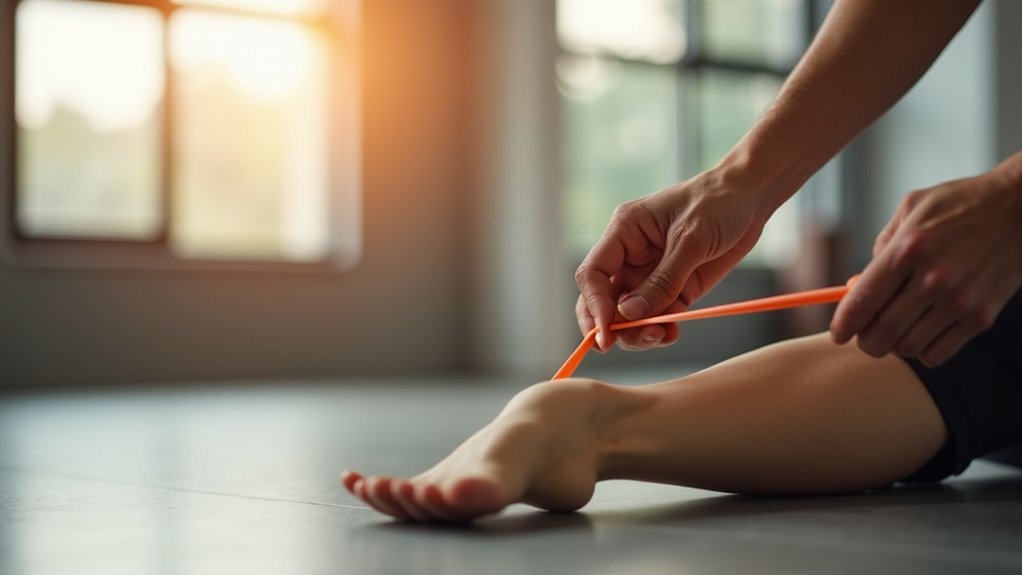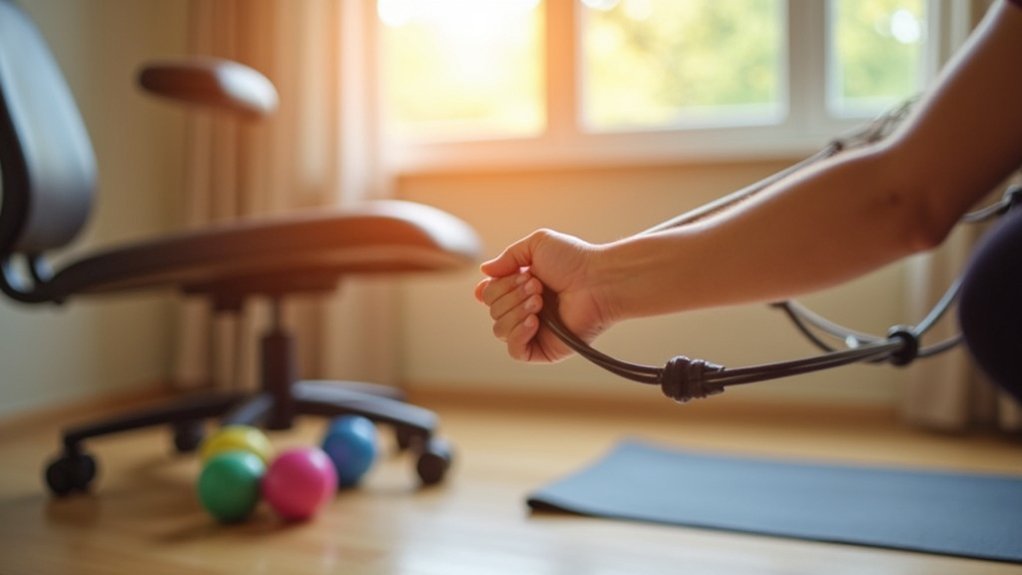Gentle resistance training eases arthritis pain by strengthening the muscles surrounding your affected joints. These stronger muscles act like natural braces, providing better support and distributing forces more evenly across your joints. You’ll experience reduced pressure on painful areas, improved stability, and enhanced mobility. The key is starting with minimal resistance, using proper form, and gradually increasing intensity. Discover how this approach can transform your joint health and considerably decrease your daily discomfort.
The Science Behind Joint Pain Reduction Through Resistance Training

While many people fear exercise might worsen arthritis pain, the scientific evidence suggests quite the opposite. Gentle resistance training actually helps alleviate joint pain by strengthening the muscles surrounding your affected joints, providing better support and reducing strain.
When you engage in resistance exercises, you’re fundamentally building a protective framework around arthritic joints. Research shows these activities can improve your muscle mass and strength by 3% to 5% per decade, countering natural declines and enhancing joint protection.
Studies consistently demonstrate that resistance training decreases pain levels while improving physical function for arthritis sufferers. The increased muscle strength reduces joint stiffness and enhances your range of motion, making daily activities more comfortable.
You’ll likely experience significant improvements in endurance and mobility, further reducing inflammation and pain.
How Muscle Development Supports Arthritic Joints
When you build muscle through gentle resistance training, you’re creating a supportive framework that helps stabilize your arthritic joints.
Your stronger muscles act like natural braces, distributing forces more evenly across the joint and reducing pressure on painful areas.
This improved force distribution means everyday movements become less taxing on damaged cartilage, allowing you to move with greater comfort and confidence.
Joint-Supporting Muscle Framework
Stability serves as the foundation for joint health in individuals with arthritis. Your joints rely on surrounding muscles to provide essential support, and gentle resistance training strengthens this natural framework.
When you develop these supportive muscles, you’re creating a protective system that distributes forces more evenly across your joints.
Three key benefits of muscle strengthening:
- Reduces pain and stiffness by providing better joint support
- Improves joint function by increasing stability during movement
- Counteracts the natural 3-5% muscle loss per decade that occurs with aging
This muscle framework doesn’t require heavy weights—body weight exercises, resistance bands, or light weights all effectively build joint-supporting strength.
Force Distribution Benefits
As your muscles strengthen through gentle resistance training, they create a more balanced load distribution across arthritic joints. This improved force distribution means less pressure concentrates on damaged areas of your joint surfaces during movement and daily activities.
When you engage in resistance training, you’re fundamentally building natural shock absorbers around your joints. These stronger muscles absorb impact forces that would otherwise be transmitted directly to painful arthritic areas. The result is reduced inflammation and discomfort during movement.
Your enhanced muscle framework also improves proprioception—your body’s awareness of position and movement—giving you better control and stability. This added control helps maintain peak joint health by preventing awkward movements that could trigger pain.
With consistent resistance training, you’ll gradually build the muscle mass needed to provide lasting support for your arthritic joints.
Adapting Exercise Equipment for Arthritis Limitations

You’ll find that specially modified grip equipment, featuring padded handles or grip aids, can transform painful exercises into manageable ones for arthritis-affected joints.
Low-impact machine adjustments, including reduced resistance settings and customized range-of-motion limits, allow you to strengthen muscles without aggravating inflamed areas.
Integrating assistive devices like resistance bands or ergonomic tools into your routine helps maintain proper form while reducing strain on vulnerable joints.
Modified Grip Equipment
Finding the right exercise tools can make all the difference when you’re managing arthritis pain. Modified grip equipment helps you maintain an effective exercise program while greatly reducing strain on sensitive joints.
Ergonomic handles and cushioned grips allow you to perform movements comfortably without aggravating pain or limiting your workout intensity.
Consider incorporating these arthritis-friendly options into your routine:
- Resistance bands with specially designed handles that require minimal gripping strength
- Lightweight dumbbells featuring contoured grips that distribute pressure evenly across your hands
- Wrist or ankle weights with easy-to-use fasteners that don’t require fine motor skills
These adaptations encourage consistent strength training, which builds supportive muscles around affected joints.
You’ll find that with the right equipment modifications, you can safely challenge yourself while protecting your joints.
Low-Impact Machine Adjustments
While specialized grips help with handheld equipment, larger exercise machines also offer excellent arthritis-friendly options with the right adjustments.
Stationary bikes and elliptical trainers can be set to lower resistance levels, accommodating your joint limitations while still providing effective workouts.
Look for machines with padded grips and adjustable seat heights to enhance your comfort and stability.
Many gyms provide equipment with customizable range of motion settings that align perfectly with your specific capabilities.
For arthritis patients, machines that focus on upper or lower body separately help manage fatigue and protect vulnerable joints.
Consider incorporating resistance bands with these machines for gentle muscle strengthening.
This combination offers progressive resistance without placing excessive strain on sensitive joints, making your fitness journey both sustainable and therapeutic.
Assistive Device Integration
When arthritis limits your mobility, the right assistive devices can transform standard exercise equipment into arthritis-friendly tools. These specialized adaptations allow you to enjoy resistance training benefits without aggravating joint pain.
Consider incorporating these assistive options into your routine:
- Lightweight resistance bands with ergonomic handles provide necessary resistance while minimizing strain on sensitive joints.
- Grip aids and therapy putty enhance your ability to perform exercises without overexerting affected areas.
- Stability balls and foam rollers improve balance and core strength, creating a safer foundation for resistance training.
Regular use of these adapted tools helps build supportive muscle around affected joints.
You’ll likely notice improved mobility and reduced pain as your body responds to this gentler approach to resistance training.
Low-Impact Resistance Techniques for Sensitive Joints

Arthritis pain doesn’t mean you need to avoid strength training altogether. Low-impact resistance exercises can actually strengthen the muscles surrounding your joints, providing better support and reducing discomfort.
Try using resistance bands or your own body weight instead of heavy equipment. These gentler options build muscle without stressing sensitive joints. Simple exercises like seated leg lifts and wall push-ups require minimal strain while delivering maximum benefits for your arthritis management.
When you incorporate these exercises into your regular routine, you’ll not only improve joint stability but also enhance your overall mobility and functional performance.
Research shows consistent practice helps prevent disability while increasing your endurance. The key to better health with arthritis lies in finding the right balance—gentle resistance that strengthens without causing additional pain.
The Role of Proper Form in Preventing Pain Flare-Ups
Because proper technique makes all the difference, mastering correct form during resistance exercises is non-negotiable for anyone managing arthritis.
When you maintain proper form, you’ll engage muscles correctly while reducing unnecessary stress on your already sensitive joints.
To protect your joints and reduce risk of pain flare-ups:
- Stabilize with your core – Engaging these central muscles provides better control during movements, preventing jarring motions that aggravate arthritis.
- Move deliberately – Perform exercises slowly and with control to enhance muscle engagement while protecting joints.
- Focus on alignment – Proper body positioning distributes forces evenly, preventing the overload that can trigger inflammation.
With consistent practice, these proper form techniques become muscle memory, creating safer exercise habits and long-term joint protection.
Building a Progressive Training Schedule for Arthritis
You’ll need to start with minimal resistance and gradually increase your workload over weeks, not days, while paying close attention to how your joints respond after each session.
Monitor your pain levels during and after exercise, distinguishing between normal muscle fatigue and joint pain that persists for hours.
Always allow 48-72 hours between training the same muscle groups to give your joints adequate recovery time and prevent inflammation from compromising your progress.
Start Slow, Progress Gradually
When living with arthritis, beginning a resistance training journey requires patient, methodical steps rather than ambitious leaps. Starting slow allows your joints to adapt without triggering flare-ups, while regular exercise builds the supporting muscles that ease pain over time.
To progress gradually with maximum benefit:
- Begin with 10-15 minute sessions using just body weight or resistance bands, then increase duration or intensity by only 10-20% each week.
- Schedule 2-3 workouts weekly with rest days in between to allow joints recovery time.
- Always include a 5-minute warm-up before training and follow with gentle stretching afterward.
Monitor how your body responds after each session, adjusting as needed. Remember that consistency matters more than intensity when building joint-supporting strength.
Monitor Pain Signals
Learning to distinguish between “good” exercise discomfort and concerning arthritis pain creates the foundation for safe, consistent progress.
Keep a detailed log tracking your pain levels before, during, and after resistance workouts to identify patterns that inform your training decisions.
When monitoring your body’s response to exercise, watch for warning signs like unusual swelling, redness, or sharp pain that persists hours after your session.
These signals indicate you should scale back intensity by 10-20% during your next workout.
Don’t hesitate to consult a physical therapist who can help interpret your pain patterns and adjust your resistance training schedule accordingly.
The most effective arthritis exercise programs evolve based on your body’s feedback, allowing you to build strength safely while minimizing symptom flares.
Rest Between Sessions
Strategic recovery periods serve as the cornerstone of effective arthritis-friendly resistance training. Your exercise routine should always include at least 48 hours of rest between working the same muscle groups, allowing your body to recover and rebuild stronger. This systematic approach helps relieve pain while promoting joint stability.
To build a successful rest schedule:
- Allow 48-hour minimum recovery for each muscle group to prevent overuse injuries and maximize strength gains.
- Monitor your body’s response – extend rest periods if pain or fatigue persists beyond normal post-workout sensations.
- Gradually increase intensity over time, always balancing challenge with adequate recovery.
This balanced approach not only protects your joints but enhances your overall health by making each resistance training session more effective in managing arthritis symptoms.
Water-Based Resistance Exercises for Joint Relief
While traditional resistance training might seem intimidating for those with arthritis, water-based exercises offer a gentle yet effective alternative. Water-based resistance exercises provide buoyancy that reduces impact on your joints while still strengthening muscles. You’ll enjoy improved joint flexibility and range of motion as the warm water helps alleviate stiffness and reduce pain during workouts.
| Exercise Type | Benefits | Difficulty Level |
|---|---|---|
| Water Aerobics | Cardiovascular health, joint mobility | Low to Moderate |
| Resistance Bands | Targeted muscle strengthening | Adjustable |
| Aqua Jogging | Lower body toning, minimal impact | Low |
| Water Yoga | Balance, flexibility, relaxation | Low to Moderate |
Resistance Band Workouts for Multiple Joint Conditions
Resistance bands offer another excellent solution for arthritis sufferers who need effective strength training without harsh joint impact.
These versatile tools help build vital muscle support around your affected joints to reduce pain while enhancing stability for everyday activities.
Strengthen the support system around painful joints, creating a foundation for improved daily function and comfort.
You’ll appreciate how resistance bands can be tailored to your specific needs:
- Customizable intensity – Use different band tensions to match your strength level and arthritis severity.
- Joint-friendly versatility – Target multiple joint conditions with a single tool, adapting exercises based on your pain levels.
- Improved mobility – Regular use decreases stiffness and enhances range of motion.
Research confirms these simple bands deliver significant improvements in functional performance.
Seated Strength Training Options for Mobility Challenges
For individuals with limited mobility due to arthritis, seated strength training offers a practical pathway to building muscle without aggravating painful joints. You can incorporate resistance bands or light weights while seated, making exercise accessible despite mobility challenges.
Exercises like seated leg lifts and arm curls provide effective options that don’t require standing or balancing. By practicing these movements consistently, you’ll experience improved muscle strength—potentially by 20-30%—which directly enhances joint support and stability.
The benefits extend beyond strength gains. Regular seated training sessions improve endurance and flexibility, contributing to better overall function and reduced arthritis symptoms.
When your supporting muscles become stronger, they take pressure off painful joints, allowing you to move more comfortably through daily activities with less fatigue.
Balancing Rest and Activity in Your Exercise Routine
Because arthritis symptoms fluctuate daily, finding the right balance between movement and recovery becomes essential for long-term joint health.
Too much rest can increase stiffness, while overexertion may trigger pain flares. The key is establishing a sustainable rhythm that supports your joints without overwhelming them.
When creating your exercise plan, focus on:
- Gradual progression – Increase your activity level by only 10-20% at a time, allowing your body to adapt without strain.
- Strategic recovery – Schedule dedicated rest days between workouts to give joints time to recuperate.
- Body awareness – Practice listening to your body’s signals and adjust accordingly on high-pain days.
Prioritize consistent, low-impact exercises like swimming or walking, which strengthen muscles while minimizing joint stress.
This balanced approach helps maintain mobility without exacerbating inflammation.
Measuring Progress Without Aggravating Symptoms
While tracking improvements in strength training typically involves lifting heavier weights, arthritis patients need a gentler approach to measuring progress. Instead, focus on small, incremental changes—like increasing repetitions or exercise duration by 10-20% over time.
Track your journey with a journal or mobile app, documenting daily exercise routines and pain levels. You’ll gain valuable insights into which exercises for osteoarthritis work best for your body. Pay attention to improvements in everyday activities, such as easier movement or reduced fatigue during routine tasks.
Regular assessment of range of motion during specific stretches can reveal meaningful progress without risking flare-ups.
Most importantly, listen to your body and adjust intensity based on immediate feedback. This guarantees you’re advancing safely while respecting your body’s limitations.
Partner-Assisted Resistance Exercises for Safety
Beyond tracking progress alone, many arthritis patients find greater success and safety when working with a partner during resistance training. Partner-assisted resistance exercises provide essential support and stability, greatly reducing your risk of injury while managing joint pain.
Working with a partner offers three key benefits:
Partner resistance training provides safety, customized intensity, and motivation—three essentials for arthritis management success.
- Improved safety – Your partner can help maintain proper form and provide immediate support when joint pain flares.
- Customized intensity – Exercises can be tailored to your comfort level, using body weight or light resistance bands.
- Enhanced motivation – Having a workout companion increases your likelihood of sticking with the routine.
This collaborative approach guarantees you perform movements within a comfortable range while receiving real-time feedback. Your partner becomes both a safety net and an accountability coach, making resistance exercises more effective and sustainable.
Incorporating Mindfulness Into Strength Training Sessions
As you engage in resistance training for arthritis management, integrating mindfulness can transform your exercise experience from merely physical to holistically therapeutic.
By focusing on your breath and body awareness during each movement, you’ll improve your technique and reduce injury risk while maximizing muscle engagement.
Mindfulness encourages you to listen to your body’s signals, allowing you to adjust exercises in real-time based on how your joints feel. This attentive approach promotes relaxation and helps manage pain during your workout.
The mind-body connection fostered through mindful exercise can also alleviate anxiety and depression that often accompany arthritis.
You’ll likely find greater enjoyment in your strength training routine when practicing mindfulness, leading to better consistency—a vital factor in experiencing the long-term benefits of resistance training for arthritis pain management.
Frequently Asked Questions
Does Resistance Training Help With Arthritis?
Yes, resistance training helps with arthritis. You’ll experience reduced pain as you strengthen muscles around your joints, providing better support. It’s also increasing your mobility and improving joint stability, enhancing your overall quality of life.
Is Gentle Exercise Good for Arthritis?
Yes, gentle exercise is excellent for your arthritis. It strengthens muscles around your joints, improves flexibility, reduces stiffness, decreases fatigue, promotes better sleep, and boosts your mood while managing pain effectively.
What Helps Excruciating Arthritis Pain?
For excruciating arthritis pain, you’ll find relief through medication, gentle exercise, hot/cold therapy, and proper rest. Don’t forget to try anti-inflammatory foods and maintain a healthy weight to reduce joint stress.
Why Does Exercise Reduce Arthritis Pain?
Exercise reduces your arthritis pain by strengthening muscles around joints, increasing synovial fluid for better lubrication, decreasing inflammation, releasing endorphins (natural painkillers), and improving your overall physical function and endurance.
In Summary
You’ve now discovered why gentle resistance training is your arthritis ally. By strengthening supporting muscles, you’re taking pressure off painful joints while improving your mobility. Remember to start slowly, listen to your body, and use proper form. With consistent practice, you’ll likely experience less pain and greater independence. Don’t let arthritis limit you—embrace these techniques and reclaim your active lifestyle.





Leave a Reply